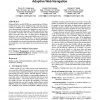71 search results - page 14 / 15 » Proximal Methods for Sparse Hierarchical Dictionary Learning |
CVPR
2010
IEEE
13 years 11 months ago
2010
IEEE
Automatic categorization of videos in a Web-scale unconstrained collection such as YouTube is a challenging task. A key issue is how to build an effective training set in the pres...
MM
2010
ACM
13 years 6 months ago
2010
ACM
The vast user-provided image tags on the popular photo sharing websites may greatly facilitate image retrieval and management. However, these tags are often imprecise and/or incom...
BMCBI
2008
13 years 5 months ago
2008
Background The use of clustering methods for the discovery of cancer subtypes has drawn a great deal of attention in the scientific community. While bioinformaticians have propose...
KDD
2002
ACM
14 years 6 months ago
2002
ACM
Relational Markov models (RMMs) are a generalization of Markov models where states can be of different types, with each type described by a different set of variables. The domain ...
HRI
2006
ACM
13 years 11 months ago
2006
ACM
Programming robots to carry out useful tasks is both a complex and non-trivial exercise. A simple and intuitive method to allow humans to train and shape robot behaviour is clearl...

